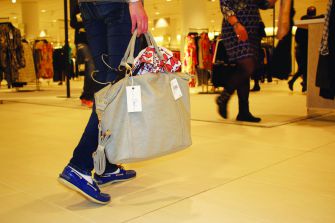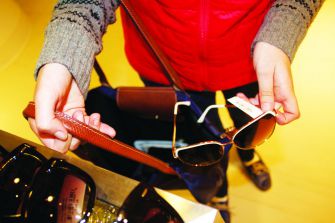Upon exiting a Sephora makeup store in San Francisco, “Claire”, an anonymous senior, walked outside with relief and reaping in the thrill that yes, “it was fun to do something bad.” But when two security guards asked her and a friend to come back inside the store, it was immediately clear that her fun was over.
Under the bright white lights of the makeup store, Claire and her friend had shoplifted nearly $200 worth of makeup in late April of their sophomore year. In a recent interview, she described how she and her friend both pulled makeup out of their containers, and then shoved them up their sleeves, and tucked more into their bags. They bought a small, inexpensive item to look less suspicious. Then they got caught.
“We didn’t need to steal it,” Claire said. “We were fortunate already and it was just something to do with my friends. It wasn’t for the stuff.”

A 2008 study by Columbia University found that shoplifting “was more prevalent among people with higher education and income.” In an affluent suburb like Marin, this suggests that financial necessity was not the primary motivation for their theft.
In the beginning of her sophomore year, Claire said she had noticed how her sister and friends kept accumulating new clothes and makeup and decided to join in on the camaraderie of shoplifters.
“My sister and my friends started taking stuff,” Claire said. “At first I was against it, but then I saw how much nice stuff they got.”
Starting when she was 14, Claire said she and her friends stole from stores like Nordstrom, Abercrombie, H & M, and Macy’s. Within the year, she estimates that she had stolen $3,000 worth of products.
“It’s so easy to steal things,” Claire said. “We’d go into the stores and you can tell if there is a sensor tag and there are ways to remove them.”
When she and her friend were caught towards the end of the year, Claire said her parents grounded her for three months and threw away all of the clothes and makeup that she had stolen.
“They didn’t trust me for months and months after that [incident],” Claire said.
A heftier consequence was Claire and her friend’s arrest for petty theft, which is a misdemeanor under California law. Her parents had to pay for all of the items she had stolen, in addition to a $500 fine, and she was banned from going into a Sephora store for the next five years.
Claire’s punishment could have been worse. Shoplifting laws as part of Penal Code 484 and 488 state that the maximum penalties for first time petty theft is a fine of up to $1,000 and/or a maximum of six months in jail. If the value of the money, property, and services stolen exceeds $50, shoplifters may have to commit to additional community service hours and attend anti-theft classes, depending on the case.
Claire says that she ultimately regrets shoplifting, and her punishment has since warned some of her friends from shoplifting again. Yet as severe as the consequences of her actions are, they have not stopped other teenagers from continuing to steal.
According to the National Association for Shoplifting Prevention (NASP), 1 in 11 people have shoplifted in the United States, and 1 in 48 of such shoplifters will be caught.
Reasons for shoplifting vary from person to person, according to Dr. Allan Gold, the school psychologist for the Reed School District. Gold suggests that peer pressure is often a large reason for other teenagers who may be in a similar situation to Claire.

“If you think about risk-taking, there is enough research to prove that some people are risk takers and some people are not,” Gold said. “So somebody who likes taking risks is more likely to be pressured into shoplifting and get a charge out of it.”
Gold says this is especially true for teenagers, whose brains have not finished developing.
“About three-fourths of kids really aren’t intending to shoplift, so it’s not always premeditated,” Gold said. “It’s the impulse control. The judgment parts of our brains generally aren’t finished until 30 years old. We used to think it was when you turn 18.”
One rare mental illness fueling teenage impulses is kleptomania, an addiction disease in which a person in unable to inhibit their urge to steal. While Gold says it is unlikely that most teens that shoplift have kleptomania, shoplifters without the disorder may have similar symptoms of stress, depression, and moodiness.
“Teenagers often have that sense of invincibility, that sense that ‘nobody’s going to catch me,’ ” Gold said.
One student who says she has yet to be caught is anonymous junior “Jane”, who says she shoplifts mainly out of necessity, as she comes from a low-income family.
“It is really hard for me to see people around here who have $85 shoes and fancy handbags and be the only one without them,” Jane said.
Jane said she started shoplifting at age 10 and has shoplifted ever since. With a pragmatic mindset, she said she conducts sophisticated plans to steal clothes for her brother, her friends, and herself because she cannot afford them otherwise.
“I mastered [shoplifting] in little ways,” Jane said. “You can bring shopping bags from other stores in and if you just slip the item in there they aren’t going to check your bags from another store… I try to go to stores when they are busy. Bigger groups are easier. Just keep your head down and keep walking. ”
She admits that by freshman year, she was shoplifting to the point of excess. She says she doesn’t shoplift as much anymore, but she still gets a rush from the activity.
“The thrill is in the thirty seconds of walking outside of the store without the sensor going out,” Jane said. “You feel both relief that you got away with it and almost pity for the store for not noticing. It’s still a little victory.”
Unlike Claire, Jane said she feels little remorse over her theft, especially at big-name stores that she feels are already wealthy. She says that each saved dollar of hers goes towards paying for her college education.
“I steal from a store that has fifty of the exact same item,” Jane said. “I don’t feel guilty about it anymore. I probably should, but I don’t.”






